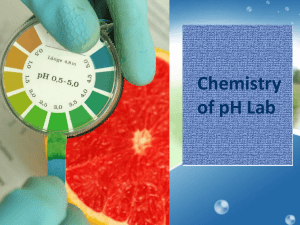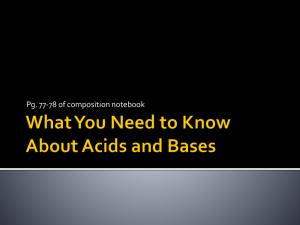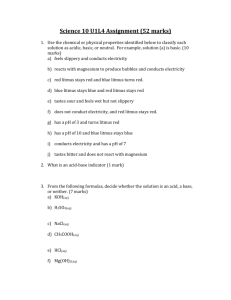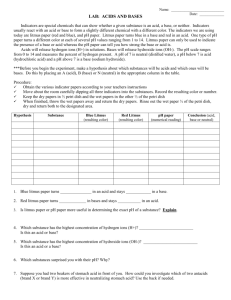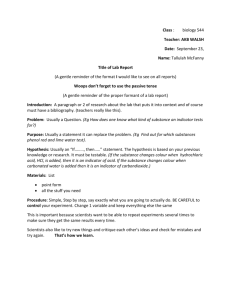Acidity, pH, and Ind..
advertisement
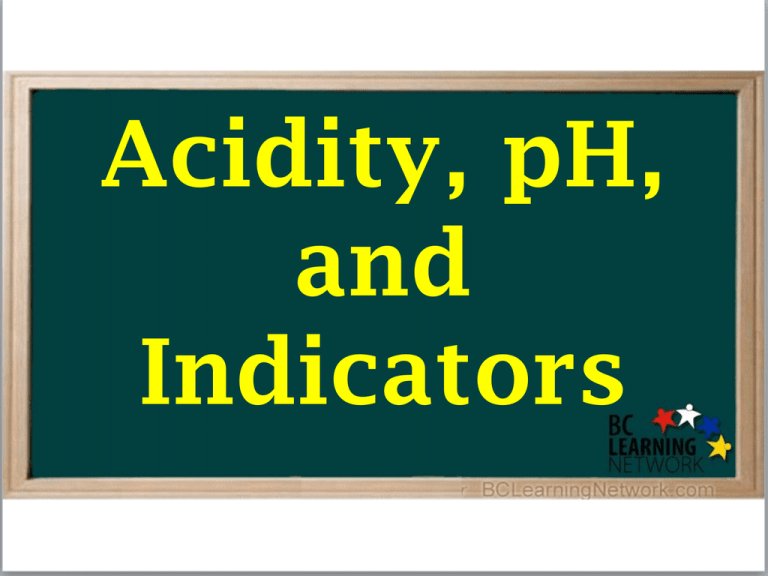
Acidity, pH, and Indicators At this point, you should be familiar with the general properties of acids and bases. At this point, you should be familiar with the general properties of acids and bases. If not, make sure you review them at this time. pH of Acidic, Basic, and Neutral Solutions The degree of acidity, The degree of acidity, or how acidic a solution is, The degree of acidity, or how acidic a solution is, is often represented by a quantity called pH. The degree of acidity, or how acidic a solution is, is often represented by a quantity called pH. “pH” has a small “p” and a capital “H”. pH is just a number, The degree of acidity, or how acidic a solution is, is often represented by a quantity called pH. “pH” has a small “p” and a capital “H”. pH is just a number, there is no unit for it. You should know what the general range in pH is for acidic solutions, You should know what the general range in pH is for acidic solutions, basic solutions, You should know what the general range in pH is for acidic solutions, basic solutions, and neutral solutions. You should know what the general range in pH is for acidic solutions, basic solutions, and neutral solutions. The pH scale diagram in the Science 10 data booklet will help you with this: You should know what the general range in pH is for acidic solutions, basic solutions, and neutral solutions. The pH scale diagram in the Science 10 data booklet will help you with this: Let’s have a look at the information in this scale: Let’s have a look at the information in this scale: Let’s have a look at the information in this scale: A Neutral solution has a pH = 7.0 Let’s have a look at the information in this scale: A Basic solution has a pH >7.0 Let’s have a look at the information in this scale: Let’s have a look at the information in this scale: Getting more acidic Getting more basic Getting more corrosive Getting more corrosive Quite corrosive Getting more corrosive Getting more corrosive Quite corrosive Getting more corrosive Getting more corrosive Non - corrosive Getting more corrosive Getting more corrosive A More Detailed Look at pH Like the Richter Scale used for comparing strength’s of earthquakes, the pH scale is a logarithmic scale. All you are required to know about this here, is that a change of one whole number in pH value represents a ten-fold change in acidity. A solution with a pH of 3 is 10 times more acidic than a solution with a pH of 4 10 × more acidic A solution with a pH of 2 is 10 times more acidic than a solution with a pH of 3 10 × more acidic How many times more acidic is a pH of 2 than a pH of 4? ? × more acidic 100 × more acidic 10 × more acidic 10 × more acidic 100 × more acidic 10 × more acidic 10 × more acidic 10 102 × more acidic 101 × more acidic 101 × more acidic pH Change in Acidity 10 Where ΔpH means the change in the value of pH pH Change in Acidity 10 Where ΔpH means the change in the value of pH pH Change in Acidity 10 Where ΔpH means the change in the value of pH pH Change in Acidity 10 Where ΔpH means the change in the value of pH Change in Acidity 10 pH Where ΔpH means the change in the value of pH A solution with a pH of 9 is times (more/less) acidic than a solution with a pH of 3. Change in Acidity 10 pH Where ΔpH means the change in the value of pH A solution with a pH of 9 is times (more/less) acidic than a solution with a pH of 3. pH 9 3 6 Change in Acidity 10 pH 10 6 Change in Acidity 10 pH Where ΔpH means the change in the value of pH A solution with a pH of 9 is times (more/less) acidic than a solution with a pH of 3. pH 9 3 6 Change in Acidity 10 pH 10 6 Change in Acidity 10 pH Where ΔpH means the change in the value of pH A solution with a pH of 9 is times (more/less) acidic than a solution with a pH of 3. pH 9 3 6 Change in Acidity 10 pH 10 6 Change in Acidity 10 pH Where ΔpH means the change in the value of pH A solution with a pH of 9 is times (more/less) acidic than a solution with a pH of 3. pH 9 3 6 Change in Acidity 10 pH 10 6 Change in Acidity 10 pH Where ΔpH means the change in the value of pH A solution with a pH of 9 is times (more/less) acidic than a solution with a pH of 3. pH 9 3 6 Change in Acidity 10 pH 10 6 Change in Acidity 10 pH Where ΔpH means the change in the value of pH A solution with a pH of 9 is times (more/less) acidic than a solution with a pH of 3. pH 9 3 6 Change in Acidity 10 pH 10 6 or 1 million A solution with a pH of 9 is106 times (more/less) acidic than a solution with a pH of 3. pH 9 3 6 Change in Acidity 10 pH 10 6 or 1 million ? A solution with a pH of 9 is106 times (more/less) acidic than a solution with a pH of 3. pH 9 3 6 Change in Acidity 10 pH 10 6 or 1 million The higher the pH of a solution is, the less acidic it is. A solution with a pH of 9 is106 times (more/less) acidic than a solution with a pH of 3. pH 9 3 6 Change in Acidity 10 pH 10 6 or 1 million The higher the pH of a solution is, the more basic, or less acidic it is. A solution with a pH of 9 is106 times less acidic than a solution with a pH of 3. pH 9 3 6 Change in Acidity 10 pH 10 6 or 1 million The higher the pH of a solution is, the more basic, or less acidic it is. A solution with a pH of 9 is106 times less acidic than a solution with a pH of 3. The higher the pH of a solution is, the more basic, or less acidic it is. A solution with a pH of 9 is106 times less acidic than a solution with a pH of 3. A solution with a pH of 9 is one million times less acidic than a solution with a pH of 3. pH Indicators A pH indicator is a substance that changes colour when a certain change in pH occurs. A pH indicator is a substance that changes colour when a certain change in pH occurs. For example, litmus is a familiar indicator. A pH indicator is a substance that changes colour when a certain change in pH occurs. For example, litmus is a familiar indicator. Paper soaked in litmus is called litmus paper and it is used to test substances to see if they are acidic, basic, or neutral. There are two main types of litmus paper: There are two main types of litmus paper: red litmus paper There are two main types of litmus paper: red litmus paper blue litmus paper There are two main types of litmus paper: red litmus paper blue litmus paper Type red litmus blue litmus Add to an Acid Add to a Base There are two main types of litmus paper: red litmus paper blue litmus paper Type red litmus blue litmus Add to an Acid Add to a Base There are two main types of litmus paper: red litmus paper blue litmus paper Type Add to an Acid red litmus stays red blue litmus Add to a Base There are two main types of litmus paper: red litmus paper blue litmus paper Type Add to an Acid red litmus stays red blue litmus Add to a Base There are two main types of litmus paper: red litmus paper blue litmus paper Type Add to an Acid Add to a Base red litmus stays red turns blue blue litmus There are two main types of litmus paper: red litmus paper blue litmus paper Type Add to an Acid Add to a Base red litmus stays red turns blue blue litmus There are two main types of litmus paper: red litmus paper blue litmus paper Type Add to an Acid Add to a Base red litmus stays red turns blue blue litmus There are two main types of litmus paper: red litmus paper blue litmus paper Type Add to an Acid Add to a Base red litmus stays red turns blue blue litmus turns red There are two main types of litmus paper: red litmus paper blue litmus paper Type Add to an Acid Add to a Base red litmus stays red turns blue blue litmus turns red There are two main types of litmus paper: red litmus paper blue litmus paper Type Add to an Acid Add to a Base red litmus stays red turns blue blue litmus turns red stays blue There are two main types of litmus paper: red litmus paper blue litmus paper Type red litmus blue litmus Add to an Neutral water There are two main types of litmus paper: red litmus paper blue litmus paper Type red litmus blue litmus Add to an Neutral water There are two main types of litmus paper: red litmus paper blue litmus paper Type Add to an Neutral water red litmus stays red blue litmus There are two main types of litmus paper: red litmus paper blue litmus paper Type Add to an Neutral water red litmus stays red blue litmus There are two main types of litmus paper: red litmus paper blue litmus paper Type Add to an Neutral water red litmus stays red blue litmus There are two main types of litmus paper: red litmus paper blue litmus paper Type Add to an Neutral water red litmus stays red blue litmus stays blue There are two main types of litmus paper: red litmus paper blue litmus paper Type Add to an Neutral water red litmus stays red blue litmus stays blue Adding either type of litmus paper to neutral water will not change its colour. If we have an unknown solution and we want to find out whether it is acidic, basic, or neutral, Type Add to an Acid Add to a Base red litmus stays red turns blue blue litmus turns red stays blue Adding either type of litmus paper to neutral water will not change its colour. If we have an unknown solution and we want to find out whether it is acidic, basic, or neutral, we could dip red and blue litmus paper into it Type Add to an Acid Add to a Base red litmus stays red turns blue blue litmus turns red stays blue Adding either type of litmus paper to neutral water will not change its colour. If we have an unknown solution and we want to find out whether it is acidic, basic, or neutral, we could dip red and blue litmus paper into it and from the results and the information below, Type Add to an Acid Add to a Base red litmus stays red turns blue blue litmus turns red stays blue Adding either type of litmus paper to neutral water will not change its colour. If we have an unknown solution and we want to find out whether it is acidic, basic, or neutral, we could dip red and blue litmus paper into it and from the results and the information below, we could find out whether it is acidic, basic, or neutral. Type Add to an Acid Add to a Base red litmus stays red turns blue blue litmus turns red stays blue Adding either type of litmus paper to neutral water will not change its colour. For example, you have a solution called Unknown 1 and: Type Add to an Acid Add to a Base red litmus stays red turns blue blue litmus turns red stays blue Adding either type of litmus paper to neutral water will not change its colour. For example, you have a solution called Unknown 1 and: Red litmus paper stays red Type Add to an Acid Add to a Base red litmus stays red turns blue blue litmus turns red stays blue Adding either type of litmus paper to neutral water will not change its colour. For example, you have a solution called Unknown 1 and: Red litmus paper stays red Blue litmus paper stays blue Type Add to an Acid Add to a Base red litmus stays red turns blue blue litmus turns red stays blue Adding either type of litmus paper to neutral water will not change its colour. For example, you have a solution called Unknown 1 and: Red litmus paper stays red Blue litmus paper stays blue Then Unknown 1 is Type Add to an Acid Add to a Base red litmus stays red turns blue blue litmus turns red stays blue Adding either type of litmus paper to neutral water will not change its colour. For example, you have a solution called Unknown 1 and: Red litmus paper stays red Blue litmus paper stays blue Then Unknown 1 is neutral Type Add to an Acid Add to a Base red litmus stays red turns blue blue litmus turns red stays blue Adding either type of litmus paper to neutral water will not change its colour. For example, you have a solution called Unknown 2 and: Type Add to an Acid Add to a Base red litmus stays red turns blue blue litmus turns red stays blue Adding either type of litmus paper to neutral water will not change its colour. For example, you have a solution called Unknown 2 and: Red litmus paper stays red Type Add to an Acid Add to a Base red litmus stays red turns blue blue litmus turns red stays blue Adding either type of litmus paper to neutral water will not change its colour. For example, you have a solution called Unknown 2 and: Red litmus paper stays red Blue litmus paper turns red Type Add to an Acid Add to a Base red litmus stays red turns blue blue litmus turns red stays blue Adding either type of litmus paper to neutral water will not change its colour. For example, you have a solution called Unknown 2 and: Red litmus paper stays red Blue litmus paper turns red Then Unknown 2 is Type Add to an Acid Add to a Base red litmus stays red turns blue blue litmus turns red stays blue Adding either type of litmus paper to neutral water will not change its colour. For example, you have a solution called Unknown 2 and: Red litmus paper stays red Blue litmus paper turns red Then Unknown 2 is acidic Type Add to an Acid Add to a Base red litmus stays red turns blue blue litmus turns red stays blue Adding either type of litmus paper to neutral water will not change its colour. Litmus paper is handy for identifying solutions as either acidic, basic or neutral. Litmus paper is handy for identifying solutions as either acidic, basic or neutral. Litmus paper is handy for identifying solutions as either acidic, basic or neutral. Litmus changes colour at a pH of 7 Litmus paper is handy for identifying solutions as either acidic, basic or neutral. If pH is below 7, litmus is red Litmus paper is handy for identifying solutions as either acidic, basic or neutral. If pH is above 7, litmus is blue Different indicators change colour at different pH values. Indicators change colour gradually, over a range of pHs. 3.2 4.4 Sloped line between pH = 3.2 and 4.4 Indicators change colour gradually, over a range of pHs. 3.2 red 4.4 yellow Methyl Orange gradually changes from red to yellow between pH = 3.2 to 4.4 Indicators change colour gradually, over a range of pHs. 3.2 red 4.4 orange yellow Methyl Orange gradually changes from red to yellow between pH = 3.2 to 4.4 Indicators change colour gradually, over a range of pHs. 3.2 red 4.4 orange yellow Methyl Orange gradually changes from red to yellow between pH = 3.2 to 4.4 Indicators change colour gradually, over a range of pHs. 3.2 red 4.4 orange yellow Methyl Orange gradually changes from red to yellow between pH = 3.2 to 4.4 Indicators change colour gradually, over a range of pHs. 3.2 red 4.4 orange yellow Methyl Orange gradually changes from red to yellow between pH = 3.2 to 4.4 Methyl Red changes from red to yellow from pH 4.8 to 6.0 Methyl Red changes from red to yellow from pH 4.8 to 6.0 Bromthymol Blue changes from yellow to blue from pH 6.0 to 7.6 Bromthymol Blue changes from yellow to blue from pH 6.0 to 7.6 Using this table, we can see what colours different indicators are at a given pH. Colours of Various Indicators at a pH of 2 At pH =2: Methyl Orange is red Methyl Red is red Bromthymol Blue is yellow Litmus is red Phenolphthalein is colourless Indigo carmine is blue Colours of Various Indicators at a pH of 2 At pH =2: Methyl Orange is red Methyl Red is red Bromthymol Blue is yellow Litmus is red Phenolphthalein is colourless Indigo carmine is blue Colours of Various Indicators at a pH of 2 At pH =2: Methyl Orange is red Methyl Red is red Bromthymol Blue is yellow Litmus is red Phenolphthalein is colourless Indigo carmine is blue Colours of Various Indicators at a pH of 2 At pH =2: Methyl Orange is red Methyl Red is red Bromthymol Blue is yellow Litmus is red Phenolphthalein is colourless Indigo carmine is blue Colours of Various Indicators at a pH of 2 At pH =2: Methyl Orange is red Methyl Red is red Bromthymol Blue is yellow Litmus is red Phenolphthalein is colourless Indigo carmine is blue Colours of Various Indicators at a pH of 2 Colours of Various Indicators at a pH of 11 Colours of Various Indicators at a pH of 11 At pH =11: Methyl Orange is yellow Methyl Red is yellow Bromthymol Blue is blue Litmus is blue Phenolphthalein is pink Indigo carmine is blue Colours of Various Indicators at a pH of 11 At pH =11: Methyl Orange is yellow Methyl Red is yellow Bromthymol Blue is blue Litmus is blue Phenolphthalein is pink Indigo carmine is blue Colours of Various Indicators at a pH of 11 At pH =11: Methyl Orange is yellow Methyl Red is yellow Bromthymol Blue is blue Litmus is blue Phenolphthalein is pink Indigo carmine is blue Colours of Various Indicators at a pH of 11 At pH =11: Methyl Orange is yellow Methyl Red is yellow Bromthymol Blue is blue Litmus is blue Phenolphthalein is pink Indigo carmine is blue Question: A solution is yellow in bromthymol blue, yellow in methyl red, and blue in indigo carmine. The pH is: a) 4.0 b) 6.0 c) 7.0 d) 8.0 Question: A solution is yellow in bromthymol blue, yellow in methyl red, and blue in indigo carmine. The pH is: a) 4.0 b) 6.0 c) 7.0 d) 8.0 Question: A solution is yellow in bromthymol blue, yellow in methyl red, and blue in indigo carmine. The pH is: a) 4.0 b) 6.0 c) 7.0 d) 8.0 Question: A solution is yellow in bromthymol blue, yellow in methyl red, and blue in indigo carmine. The pH is: a) 4.0 b) 6.0 c) 7.0 d) 8.0 Question: A solution is yellow in bromthymol blue, yellow in methyl red, and blue in indigo carmine. The pH is: a) 4.0 b) 6.0 c) 7.0 d) 8.0 Question: A solution is yellow in bromthymol blue, yellow in methyl red, and blue in indigo carmine. The pH is: a) 4.0 b) 6.0 c) 7.0 d) 8.0 Question: A solution is yellow in bromthymol blue, yellow in methyl red, and blue in indigo carmine. The pH is: a) 4.0 b) 6.0 c) 7.0 d) 8.0 Question: A solution is yellow in bromthymol blue, yellow in methyl red, and blue in indigo carmine. The pH is: a) 4.0 b) 6.0 c) 7.0 d) 8.0 Question: A solution is yellow in bromthymol blue, yellow in methyl red, and blue in indigo carmine. The pH is: a) 4.0 b) 6.0 c) 7.0 d) 8.0 Question: A solution is yellow in bromthymol blue, yellow in methyl red, and blue in indigo carmine. The pH is: a) 4.0 b) 6.0 c) 7.0 d) 8.0 Question: A solution is yellow in bromthymol blue, yellow in methyl red, and blue in indigo carmine. The pH is: a) 4.0 b) 6.0 c) 7.0 d) 8.0 Question: A solution is yellow in methyl orange, pink in phenolphthalein, and green in indigo carmine. The pH is: a) 5.0 b) 6.5 c) 12.5 d) 14.0 Question: A solution is yellow in methyl orange, pink in phenolphthalein, and green in indigo carmine. The pH is: a) 5.0 b) 6.5 c) 12.5 d) 14.0 Question: A solution is yellow in methyl orange, pink in phenolphthalein, and green in indigo carmine. The pH is: a) 5.0 b) 6.5 c) 12.5 d) 14.0 Question: A solution is yellow in methyl orange, pink in phenolphthalein, and green in indigo carmine. The pH is: a) 5.0 b) 6.5 c) 12.5 d) 14.0 Question: A solution is yellow in methyl orange, pink in phenolphthalein, and green in indigo carmine. The pH is: a) 5.0 b) 6.5 c) 12.5 d) 14.0 Question: A solution is yellow in methyl orange, pink in phenolphthalein, and green in indigo carmine. The pH is: a) 5.0 b) 6.5 c) 12.5 d) 14.0
